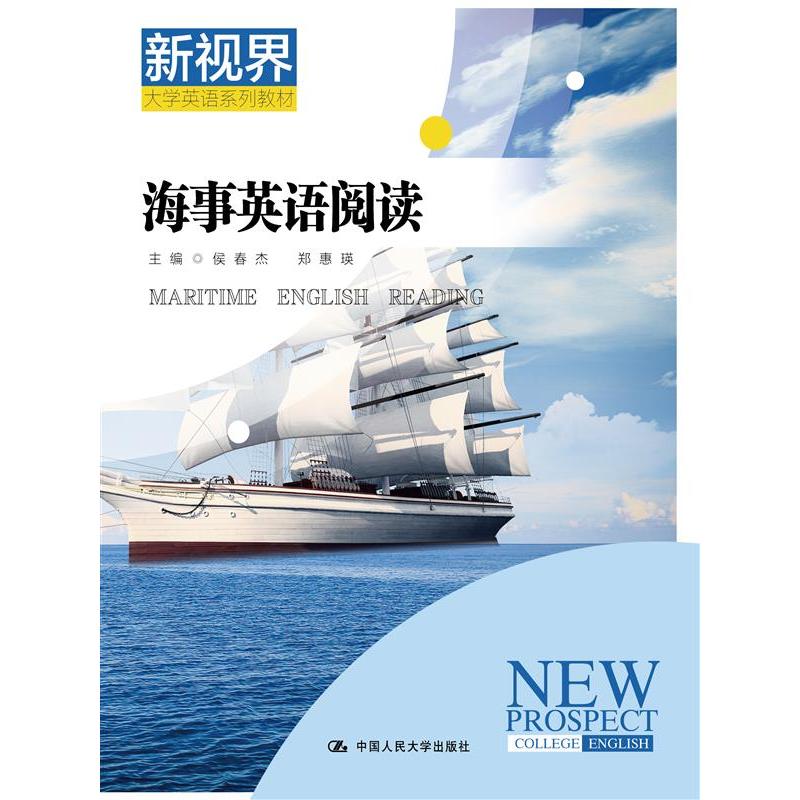
出版社: 中国人民大学
原售价: 58.00
折扣价: 45.30
折扣购买: 海事英语阅读(新视界大学英语系列教材)
ISBN: 9787300326795

侯春杰,集美大学外国语学院副教授,长期从事大学英语教学并担任教研室主任,主要研究方向为功能语言学、语用学和语言教学,曾主持市厅级以上课题2项,其他课题多项,参与课题多项,发表论文十余篇,主编教材两套。 郑惠瑛,女,厦门大学英语语言文学硕士,美国得克萨斯农工大学访问学者,现为集美大学外国语学院讲师,研究方向为英语教学法和心理语言学。长期从事航海专业大学英语教学工作,2019年外研社“教学之星”大赛复赛特等奖,半决赛二等奖;2020年《海上丝绸之路》获“集美大学优质课程”(排名第二);2021集美大学教师教学创新大赛二等奖。主持或参与多项省厅级、校级课题,主编教材两套,并发表数篇论文,曾获得 “优秀班主任”“南顺奖教金”等荣誉称号。
Unit 1
Text A
Pre-reading Activities
Directions: Watch the video How the Ancient Silk Road Pioneered Globalization and answer the following questions.
1. What makes silk the most popular goods in ancient global trade?
2. According to many historians, what is the greatest impact of the Silk Road?
3. What’s the reason for the emergence of cities like Venice and Istanbul?
Maritime Silk Road
The Silk Road is a historically important international trade route between China and the Mediterranean. Because China silk comprised a large proportion of the trade along this ancient road, in 1877, it was named the “Silk Road” by Ferdinand von Richthofen, an eminent German geographer.
In order to distinguish it from the traditional Silk Road, the maritime trade route linking the East and West was given the name “Silk Road on the Sea” by a Japanese scholar in 1967. The two most favored courses followed by trade ships were those of the East China and South China Sea Routes.
East China Sea Route
The East China Sea Route enjoys a long history of about 3,000 years. It was during the Zhou Dynasty that Ji Zi (箕子), a court official, was sent on a journey east, setting off from Shandong Peninsula’s Bohai Gulf and navigating his way across the Yellow Sea, which led to the introduction of sericiculture (silkworm farming), filature and silk spinning into Korea.
When Emperor Qin Shi Huang united China, many Chinese fled to Korea and took with them silkworms and breeding technology. This sped up the development of silk spinning in Korea. These new skills and the technologies were subsequently introduced into Japan during the Han Dynasty. Since the Tang Dynasty, the silks produced by Jiangsu and Zhejiang Provinces were directly shipped to Japan. Many Japanese envoys and monks were also able to travel to Chang’an (now Xi’an) along this sea route.
South China Sea Route
Guangzhou represented the starting-point of the South China Sea Route, which extended across the Indian Ocean and then on to various countries situated around the Persian Gulf. The types of goods dispatched for trade consisted mainly of silk, china and tea, while imported merchandise included a variety of spices, flowers and glass — hence it being commonly referred to as the sea’s “China Road” and the sea’s “Flavor Road”.
The route was first used in the Qin and Han Dynasties, and increased in popularity from the Three Kingdoms Period (220–280) to the Sui Dynasty (581–618). Up until the Tang Dynasty Anshi Rebellions (755–763), this route was viewed as a secondary alternative to the Silk Road. Around the 7th century, during the Tang Dynasty, 500 years before Marco Polo arrived in China, Silk Road land routes fell into decline as sea routes opened up between China and the Middle East.